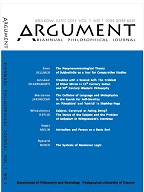The Collision of Language and Metaphysics in the Search for Self-Identity: on 'ahamkara' and 'asmita' in Samkhya-Yoga
The Collision of Language and Metaphysics in the Search for Self-Identity: on 'ahamkara' and 'asmita' in Samkhya-Yoga37-48
Author(s): Marzenna JakubczakSubject(s): Philosophy
Published by: Wydawnictwo Uniwersytetu Komisji Edukacji Narodowej w Krakowie
Keywords: ahamkara; asmita; ego; self; Hindu philosophy; Indian philosophy; Samkhya; Yoga; language; self-identity; self-knowledge; subjectivity; liberation; paralogism; grammar and philosophy
Summary/Abstract: Tha author of this paper discusses three major points: (1) a significant feature of linguistic analysis in the classical Indian philosophical tradition; (2) the role of the religious practice (iśvara-pranidhana) in the search for true self-identity in Samklhya and Yoga schools (darśanas) with special reference to their gnoseological purposes; and (3) some possible readings of 'ahamkara' and 'asmita' displayed in the context of Samkhya-Yoga phenomenology and metaphysics. The collision of language and metaphysics refers to the risk of paralogism caused by the common linguistic procedures making the subject define its identity within the actual metaphysical situation of the self, though it determines one's self-understanding in the empirical sense. Whereas Samkhya-Yoga aims at recognizing, reorganizing and, finally, going beyond these procedures regarded as the obstacles on the path towards self-knowledge and liberation from metaphysical ignorance.
Journal: ARGUMENT: Biannual Philosophical Journal
- Issue Year: I/2011
- Issue No: 1
- Page Range: 37-48
- Page Count: 12
- Language: English

